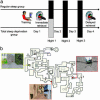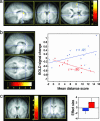Sleep after spatial learning promotes covert reorganization of brain activity
- PMID: 16636288
- PMCID: PMC1459028
- DOI: 10.1073/pnas.0510198103
Sleep after spatial learning promotes covert reorganization of brain activity
Abstract
Sleep promotes the integration of recently acquired spatial memories into cerebral networks for the long term. In this study, we examined how sleep deprivation hinders this consolidation process. Using functional MRI, we mapped regional cerebral activity during place-finding navigation in a virtual town, immediately after learning and 3 days later, in subjects either allowed regular sleep (RS) or totally sleep-deprived (TSD) on the first posttraining night. At immediate and delayed retrieval, place-finding navigation elicited increased brain activity in an extended hippocampo-neocortical network in both RS and TSD subjects. Behavioral performance was equivalent between groups. However, striatal navigation-related activity increased more at delayed retrieval in RS than in TSD subjects. Furthermore, correlations between striatal response and behavioral performance, as well as functional connectivity between the striatum and the hippocampus, were modulated by posttraining sleep. These data suggest that brain activity is restructured during sleep in such a way that navigation in the virtual environment, initially related to a hippocampus-dependent spatial strategy, becomes progressively contingent in part on a response-based strategy mediated by the striatum. Both neural strategies eventually relate to equivalent performance levels, indicating that covert reorganization of brain patterns underlying navigation after sleep is not necessarily accompanied by overt changes in behavior.
Conflict of interest statement
Conflict of interest statement: No conflicts declared.
Figures



References
-
- Maquet P., Smith C., Stickgold R. Sleep and Brain Plasticity. Oxford: Oxford Univ. Press; 2003.
-
- Peigneux P., Laureys S., Delbeuck X., Maquet P. NeuroReport. 2001;12:A111–A124. - PubMed
-
- Rauchs G., Desgranges B., Foret J., Eustache F. J. Sleep Res. 2005;14:123–140. - PubMed
-
- Walker M. P., Stickgold R. Annu. Rev. Psychol. 2006;57:1–28. - PubMed
Publication types
MeSH terms
LinkOut - more resources
Full Text Sources

